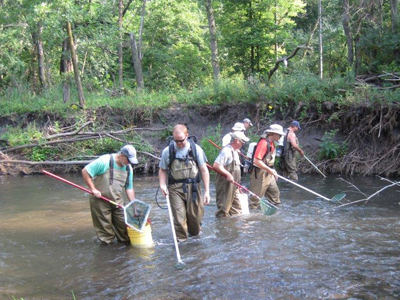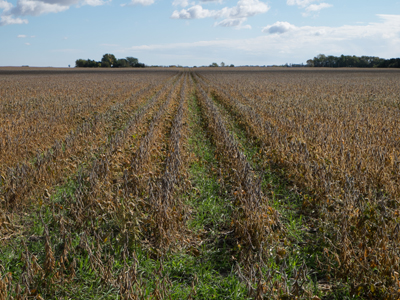Watershed Wednesday: Embracing an Adaptive Management Approach
posted
on Tuesday, January 19, 2016
Note: This article is the third in a month-long series of Watershed Wednesday blog posts about a watershed approach for Iowa. Click here to view other articles in the series.
 |
| Photo courtesy of Natural Resources Conservation Service. |
Effective action relies on obtaining good, up-to-date information that shows what is and is not working – and planning next steps accordingly. This concept, known as “adaptive management,” is often discussed as a critical part of a watershed approach, and landowners in northeast Iowa’s Rock Creek watershed have embraced it. Not only did they help create their own watershed plan, they are helping collect the data to guide its implementation.
Farmer Wayne Fredericks, a leader in the Rock Creek effort, spoke about lessons learned from his involvement recently at the Sustaining Our Iowa Land (SOIL) Conference at Drake University.
“Our farmers support evaluation and monitoring so that we know if we’re making improvements,” said Fredericks, who is also president of the Iowa Soybean Association (ISA). “We want to know whether the practices we’re using are going to be cost-effective.”
Rock Creek Watershed, southwest of Osage, is mostly agricultural. It drains about 45,000 acres of Mitchell and Worth counties into the Cedar River. As early as 2006, landowners in the watershed started organizing to improve water quality with the help of the Mitchell County Soil and Water Conservation District (SWCD) and the Iowa Department of Natural Resources (IDNR).
The group received a grant from the Walton Family Foundation to develop a plan, which ISA coordinated. The resulting Rock Creek Watershed Plan: A Roadmap for Improved Water, Soil and Habitat in the Rock Creek Watershed lays out a phased approach to ensure continuous improvements are being made. Its goals are to:
1. Reduce in-stream nitrogen by 41% from 2009-2011 average levels.
2. Reduce in-stream phosphorus by 29% from 2009-2011 average levels.
3. Increase soil organic matter by 1%.
4. Maintain or increase agricultural productivity and revenues.
5. Reduce flood risk.
6. Maintain or increase upland wildlife habitats.
7. Maintain or improve aquatic life.
 |
| Photo courtesy of Iowa Soybean Association. |
The Rock Creek plan includes an emphasis on data, measurement and monitoring. Even before the plan, the Mitchell SWCD began taking water samples from Rock Creek, checking for nitrate, phosphorus, turbidity, bacteria among other pollutants. New water testing sites have been added and producers sample 15 tile outlets, with help from the ISA. They’re also measuring success by modeling expected results from adoption of practices like cover crops and a new water-filtration wetland. Last summer, the Iowa Department of Agriculture and Land Stewardship pledged more than $387,000 to support the project, which is supplemented by federal funds and investments of time and cash for cost-share by the landowners.
Kurt Hoeft, Natural Resources Conservation Service District Conservationist for Howard and Mitchell counties, says that the Rock Creek watershed plan is guiding how the money is used, and water sampling is helping find the best locations for conservation practices to reduce pollutants flowing into Rock Creek. The long-term in-stream monitoring results are also being watched for trends. While locating the source of the bacteria impairment has been elusive, he says, they are starting to see some encouraging results in terms of decreasing nitrates.
Changes are also evident on the landscape. More than 50 landowners have signed up to apply new conservation practices, and they have planted several thousand acres of cover crops. NRCS’ Hoeft credits progress to the joint efforts of many partners, including the farmers, ISA, the IDNR, ag retailers and Pheasants Forever.
Back to Wayne Fredericks and his lessons learned: “Not all watersheds are the same,” he said. “A tailored watershed plan is key to guide implementation and empower local individuals and groups to take ownership.”
We agree. All watersheds are unique. That’s why it is so important to have a tailored plan with local goals and ongoing monitoring to help measure progress and guide adaptive management. To significantly improve water quality, Iowa needs a statewide watershed framework that implements the type of approach being taken in the Rock Creek watershed. The Council applauds the partners working in Rock Creek for their Vision and Leadership.
Learn more at www.iasoybeans.com
- conservation
- water quality
- watershed wednesday